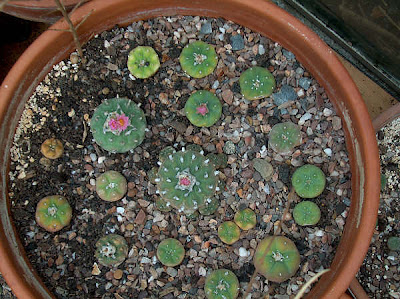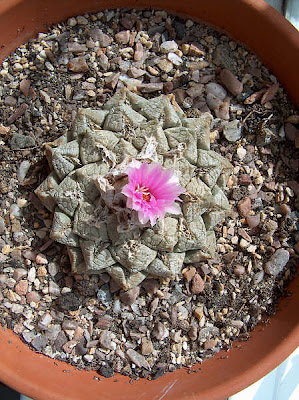Dirk is a lucky man. Anyway, judged by the quality of his collection of crested and variegated cacti, he has to be ;-) I think you’ll agree after seeing the pictures that Dirk has been kind enough to let me share in this post.

Ariocarpus retusus var. elongata crest
I’m particularly fond of this photo of a cristate Ariocarpus retusus, resembling a plant creature one would not be too surprised to encounter in a Tolkien novel.
Dirk is living in Belgium and knows a commercial cactus grower in Holland who lets him pick and choose interesting seedlings when he’s visiting (to stock up on Harrisia for grafting). On this account Dirk has got quite a collection of variegated Lophophora.

Lophophora williamsii f. variegata
I especially like the pastel pink, yellow, and green colors of the above plant – it’s almost a wine gum look-alike ;-) But the rest of the collection is definitely also nice.

Lophophora williamsii f. variegata grafted on Harrisia

Lophophora williamsii f. variegata 'Zebra'
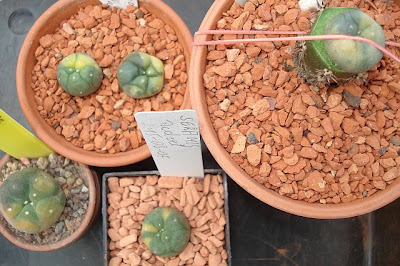
Collection of variegated Lophophora williamsii
Dirk also has plants showing dichotomous branching like these beautifully symmetric two-headed Obregonia denegrii and Lophophora williamsii plants.

Two-headed Obregonia denegrii

Collection of two-headed Lophophora williamsii
Last I heard from Dirk he had just returned from a visit to the 2007 ELK. He had tried to obtain a cristate Lophophora – unfortunately without any luck. You can see more of Dirk’s amazing collection at his cactelders web site.
I hope you enjoyed this featured collection - if you have pictures or information you would like to share, you can drop me a mail at “lophophora [dot] blog [at] gmail [dot] com”.
Monday, September 24, 2007
Dirk’s collection of cristate and variegated cacti
Wednesday, July 04, 2007
Rory’s Lophophora collection
Some time ago Rory contacted me to discuss cacti and mycorrhizal associations (an interesting subject that might be brought up in a later post). During our conversations Rory revealed himself as an avid Lophophora grower with an impressive collection of mature and well-grown plants. Rory has kindly allowed me to share some pictures of his plants.
Flowering Lophophora williamsii, close-up
Large pot of Lophophora williamsii
The largest of the L. williamsii plants in this pot are approximately 25 years old. One of the plants in the central group (a bit above and to the left of the center) has been decapitated and set 4 offshoots. One of these has not yet developed a central growing point and appears somewhat cristate, but Rory expects it to develop as normal with time. The removed top was rooted and is also growing in the central group of plants (slightly below center; wool removed from areoles), and is flowering regularly.
Large pot of Lophophora fricii
According to Rory the compost used for the L. fricii plants are not drying fast enough. Consequently the plants are kept on the dry side which accounts for the red coloration shown by some of them. The largest of the plants (with a total of 9 offsets) has only grown 1cm (~0.4'') in the past 9 years so Rory is planning on repotting the plants in a new mix and expects this to speed up growth.
Lophophora diffusa about to flower
The above L. echinata diffusa plant is just about to flower - unfortunately it’s too overcast for the flowers to open properly.
Large pot of Lophophora williamsii v .caespitosa
To top things off (or just to make me completely envious ;-) Rory also threw in a photo of a nice, mature Ariocarpus fissuratus specimen.
Flowering Ariocarpus fissuratus
I hope you enjoyed this “guest appearance” - I for one would like to see more of Rory’s plants. If you have pictures or information you would like to share, you can drop me a mail at “lophophora [dot] blog [at] gmail [dot] com”.
Monday, March 05, 2007
Seed starting Lophophora, Ariocarpus, and Epithelantha
The last couple of days I’ve been busy starting the next generation of plants from seed. One of the more interesting lophs this year is a variety of Lophophora williamsii originating from El Oso, Coahuila, Mexico. According to The genus Lophophora – Kaktusy Special 2, 2005 this variety forms massive clusters with individual heads measuring up to 15 cm (5.9'') in diameter! Unfortunately it seems the El Oso site is severely threatened by agricultural activities.

Lophophora williamsii - El Oso, Coahuila (picture taken from The genus Lophophora – Kaktusy Special 2, 2005)
I’ve sown the following Lophophora seeds this year:
- Lophophora diffusa v. koehresii (RS 1182; El Sabino, San Luis Potosí)
- Lophophora diffusa ssp. kubesai (JJH 0010892; Puente Mezquitio, Querétaro)
- Lophophora fricii (RS 404B; Viesca, Coahuila)
- Lophophora williamsii (MMR 89; El Oso, Coahuila)
- Lophophora williamsii (RS 428A; Cuatro Ciénegas, Coahuila)
 Lophophora diffusa ssp. kubesai
In addition to the Lophophora seeds I also started a handful of Ariocarpus from seed:
Lophophora diffusa ssp. kubesai
In addition to the Lophophora seeds I also started a handful of Ariocarpus from seed:
- Ariocarpus fissuratus (JDL 26; Hot Springs, Big Bend, Texas)
- Ariocarpus fissuratus (VVZ 204; Terlingua, Texas)
- Ariocarpus fissuratus (VVZ 205; North of Alpine Texas)
- Ariocarpus kotschoubeyanus v. macdowellii (RS 134; Hipolito, Coahuila)
- Epithelantha micromeris (JM 101; Sitting Bull Canyon, New Mexico)
- Epithelantha micromeris v. gregii (MMR 179; El Oso, Coahuila)
Tuesday, January 31, 2006
Flowering Ariocarpus fissuratus var. hintonii
None of my Ariocarpi have flowered yet, but this video (1.1MB) of a flowering Ariocarpus fissuratus var. hintonii gives a good impression of what to expect. 
Flowering Ariocarpus fissuratus var. hintonii
More amazing videos of flowering cacti can be found at the Hydrocactus video page.
Monday, December 19, 2005
Ariocarpus & Epithelantha
I’m just home from California, slightly worn and jet-lagged. Again I took the opportunity and ordered plants from Mesa Garden to be delivered to my US hotel address (and again the plants are immaculate).
I received the plants listed below (all in the range of 10 years old from seed) and a couple of Opuntias for my winter hardy collection. The Ariocarpus and Epithelantha plants were potted yesterday in a mix of primarily limestone gravel, some loamy sand, and a bit of commercial cactus soil.
Ariocarpus fissuratus (SB413)
Brewster County, Texas, USA
Ariocarpus fissuratus (SB413)
The plants are approximately 2.5-3 cm (~ 1-1.2’’) wide, and 6.5-7 cm (~ 2.5-2.75’’) high.
Ariocarpus retusus (SB334)
Huizache, San Luis Potosi, Mexico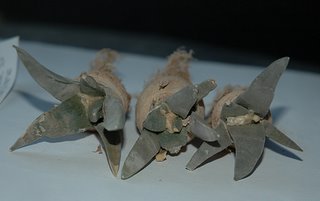
Ariocarpus retusus (SB334)
The plants are approximately 2.5-2.7 cm (~ 1’’) wide, and 7 cm (2.75’’) high.
Epithelantha bokei (SB416)
Brewster County, Texas, USA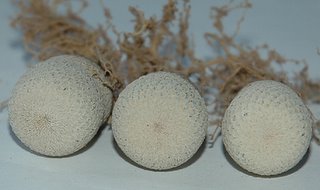
Epithelantha bokei (SB416)
The plants are approximately 1.5 cm (~ 0.6’’) wide, and 2.2 cm (~ 0.87’’) high (measured without the root).
Monday, November 07, 2005
Ariocarpus fissuratus (JM122)
Another trip to California, another batch of plants from Mesa Garden.
Apart from winter hardy species of Escobaria, Echinocereus, and Opuntia, I also received three Ariocarpus fissuratus plants (JM122, Fort Stockton, Pecos Co., Texas) and another Strombocactus disciformis (SB174).
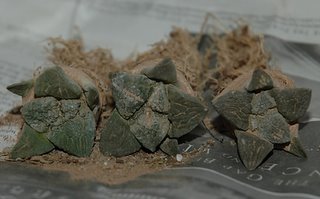
Ariocarpus fissuratus (JM122) plants - top view
The Ariocarpi are approximately 2.5 cm (~ 1’’) wide, 6.5 cm (~ 2.5’’) high, and an amazing 8 years old – a great illustration of the quote “Ariocarpus, Cacti for the Young (or Young at Heart)”.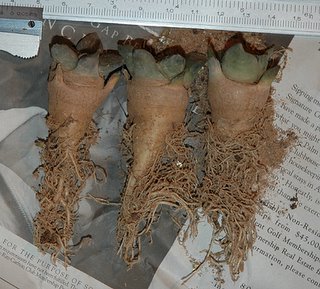
Ariocarpus fissuratus (JM122) plants - full view
I potted the Ariocarpi yesterday in a mix consisting primarily of limestone gravel with some loamy sand and a tad of regular potting soil added.
Strombocactus disciformis (SB174, Vizarron, Queretaro)
The new Strombocactus disciformis plant is 1.35 cm (~ 0.5’’) wide and 2.1 cm (~ 0.8’’) high, and is now growing with the two Strombos received previously.
Strombocactus disciformis (SB174)
I must mention that I’m impressed with the quality of the plants and the service received from Steve Brack.
Monday, August 22, 2005
Obregonia and Ariocarpus from seed – IV
The sowing bags have been open for the last week, and yesterday the seedling plants were removed from the bags and fully exposed to the real world environment. The 30+ Obregonia denegrii (VVZ 163; San Vicente, Tamaulipas) seedlings are growing vigorously, and I’m already wondering how to find room for all the plants ;-)
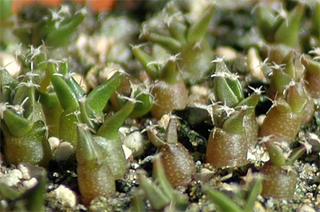
Obregonia denegrii seedlings
The 6 Ariocarpus fissuratus (PP 176; Big Bend, Texas) seedlings also started out convincingly but after growing a couple of diminutive tubercles each, their growth grinded to a halt. I’m a bit disappointed with the germination rate of these A. fissuratus seeds and will probably try again next year with seeds from a different supplier.
< previous |
Monday, March 14, 2005
Obregonia and Ariocarpus from seed - III
Very few of my Ariocarpus fissuratus seed have germinated. Currently I have 3 thriving seedlings - and a corresponding number that dampened off. I'll keep the seedlings in a varm, humid environment for a while; hopefully more seed will germinate. I'm not sure if I'm treating the seed wrong, if the quality of the seed were inferior, or if A. fissuratus is just hard to grow from seed.
The germination rate of the Obregonia denegrii seed is close to a 100% (the seed were treated in exactly the same way as the A. fissuratus seed). The seedlings have been moved to a slightly cooler location, and soon I'll slowly introduce them to the harsh world outside the growing bag.
< previous | next >
Sunday, February 13, 2005
Obregonia and Ariocarpus from seed - II
Two days ago, at the beginning of the weekend, there were not many signs that the Obregonia or Ariocarpus seed would germinate. Tonight more than half of the Obregonia and a few of the Ariocarpus seed had germinated.
The seedlings still have a pale, yellowish hue - hopefully they will take on a healthier chlorophyll-green in a couple of days.
< previous | next >
Saturday, February 05, 2005
Obregonia and Ariocarpus from seed
It’s probably too early in the year, but today seemed like a good day for sowing:
- Obregonia denegrii (VVZ 163; San Vicente, Tamaulipas)
- Ariocarpus fissuratus (PP 176; Big Bend, Texas)
The seed (30something of each species) were handled as described in “Growing cacti from seed”.
I’m holding my Lophophora seed back – I’m planning on sowing an indoor batch in early spring and a cold house batch in late spring.
| next >
Saturday, January 01, 2000
31. Ariocarpus
Scheidweiler, Bull. Acad. Roy. Sci. Bruxelles. 5: 491, figs. 1-5. 1838.
[The genus Aria and Greek karpos, fruit, referring to the Aria-like fruit]
Allan D. Zimmerman & Bruce D. Parfitt
Neogomesia Castañeda; Roseocactus A. Berger
Plants erect, unbranched [or branched], deep-seated in the substrate [or somewhat subterranean for whole seasons]. Roots taproots. Stem unsegmented, gray-green (yellow-green or purplish with age or stress), above-ground portion flat, concave, or weakly hemispheric, usually flush with soil surface and cryptic, strongly tuberculate, 0-2(-10) × [3-]5-10(-15) cm, hard, rigid, tough skinned [thin skinned in A. agavoides of Mexico]; tubercles arranged in rosettes or mosaics, ± triangular, 8-20[-60] × [3-]11-25 mm, hard, exposed faces of tubercles strongly differentiated from sides [except in some Mexican species], prominently fissured [wrinkled, roughened, or nearly smooth]; areoles elongate [circular and axillary, circular and subapical, or 2-parted], forming a wide woolly groove on each tubercle; areolar glands absent; cortex and pith not mucilaginous, "mucilage" restricted to elongate cavities. Spines absent [sporadic and rudimentary in some Mexican taxa]. Flowers diurnal, borne in axils of tubercles near stem apex, broadly funnelform to almost salverform, 1.5-5 × 1.5-5 cm; outer tepals brownish or greenish with pink tinge, 12-35 × 5-9 mm, margins entire; inner tepals pink or magenta [white or yellow], 13-34 × 4-10 mm, margins entire; ovary smooth (scales, hairs, and spines absent); stigma lobes 5-10, white, 1.2-5 mm. Fruits indehiscent (very rarely explosively dehiscent), white or cream to pale greenish [reddish], spheric to clavate or cylindric, proximally or almost completely buried in copious wool of stem apex, 10-25 × 5-10 mm, initially fleshy, drying and collapsing a few days after ripening, scales and spines absent; pulp white to pale greenish; floral remnant apparently persistent. Seeds black, spheric to obovoid, 1.2-1.6(-2.5) mm, minutely tuberculate, shiny; testa cells strongly convex (conspicuous with lens). x = 11.
Species 6 (1 in the flora): arid regions, sw United States, Mexico.
Ariocarpus species mostly grow in broken rock substrate and closely mimic it. Some Mexican species display additional adaptations, e.g., A. kotschoubeyanus (K. Schumann) K. Schumann withdraws into seasonally inundated, fine lacustrine soil and can be completely buried between growing seasons.
SELECTED REFERENCES Anderson, E. F. 1965. A taxonomic revision of Ariocarpus. Cact. Succ. J. (Los Angeles) 37: 39-49. Anderson, E. F. and W. A. Fitz Maurice. 1997. Ariocarpus revisited. Haseltonia 5: 1-20.
1. Ariocarpus fissuratus (Engelmann) K. Schumann in H. G. A. Engler and K. Prantl, Nat. Pflanzenfam. 106[III,6a]: 195. 1894.
Living-rock cactus, star cactus, chaute, chautle
Mammillaria fissuratus Engelmann, Proc. Amer. Acad. Arts 3: 270. 1856 (as Mamillaria)
Varieties 1-3 (1 in the flora): Texas, Mexico.
1a. Ariocarpus fissuratus (Engelmann) K. Schumann var. fissuratus
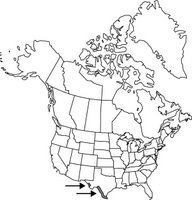 Plants protruding above ground 0-2(-10) cm. Stems: tubercles forming coarse mosaic, closely packed, exposed faces of tubercles deltoid to hemispheric, deeply fissured on either side of central areolar groove, coarsely rugose, often sharply angled apically; areoles to 3 mm wide, sometimes confined to middle of tubercle faces instead of extending to tips. Flowers 2.5-5 cm diam., 2 times wider than long when fully expanded; inner tepals 21-30 × 5.5-7.5(-10) mm.
Plants protruding above ground 0-2(-10) cm. Stems: tubercles forming coarse mosaic, closely packed, exposed faces of tubercles deltoid to hemispheric, deeply fissured on either side of central areolar groove, coarsely rugose, often sharply angled apically; areoles to 3 mm wide, sometimes confined to middle of tubercle faces instead of extending to tips. Flowers 2.5-5 cm diam., 2 times wider than long when fully expanded; inner tepals 21-30 × 5.5-7.5(-10) mm.
Flowering Sep-Nov. Chihuahuan desert scrub, low, rocky hills of limestone chips; 500-1500 m; Tex.; Mexico (Chihuahua, Coahuila, Durango).
The stems of Ariocarpus fissuratus are normally flush with the soil surface and resemble limestone chips in shape, color, and texture, rendering the plants extremely cryptic. The species is often found growing with Agave lechuguilla and species of Leucophyllum, and Parthenium.

Back to online articles.
The Flora of North America web site.
All Time Most Popular Posts
-
On various occasions I've been asked what growing media I'm using for my cactus plants. I don't have a set soil mix recipe as su...
-
Lophophora williamsii (peyote) populations have diminished in large areas of South Texas where peyoteros harvest the cactus for ceremonial ...
-
Below is a list of retailers/nurseries selling cactus seed and plants. I've only listed vendors I've done business with. If you ar...
-
Most cacti are easily grown from seed - and with a little patience and care they can be grown into beautiful plants. Lophophora williamsi...
-
In last month’s post on the troubled Texan peyoteros I referred to Anderson’s article on the peyote situation in Texas. Given the importanc...
-
Yet another slightly off topic and probably not entirely politically correct post, but I couldn’t help noticing the similarity of my monstr...
-
Flowering stand of San Pedro cacti (Trichocereus pachanoi) To me the main draw of the San Pedro cactus ( Trichocereus pachanoi (syn. Ech...
-
In the June 2008 issue of the Cactus & Co magazine Jaroslav Šnicer, Jaroslav Bohata, and Vojtěch Myšák described a new Lophophora spec...
-
There seems to be an increased focus on the alarming Texas peyote situation. A couple of weeks ago the Houston Press published a mournful, i...
-
I spent two weeks working in Delhi, India during January. I had one weekend off and had planned to spend it in Delhi at my own leisure, but ...


